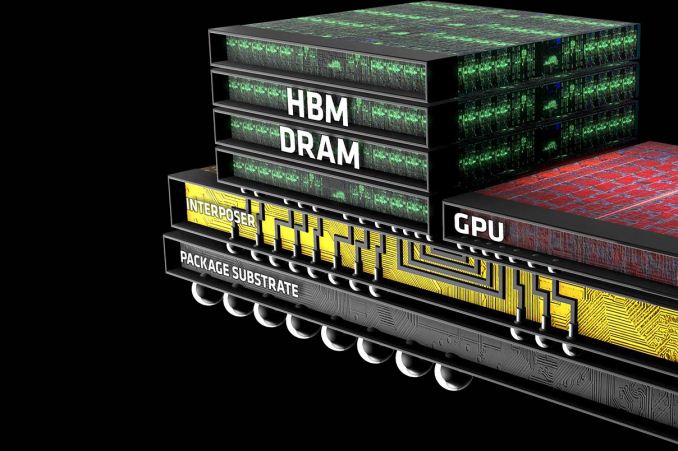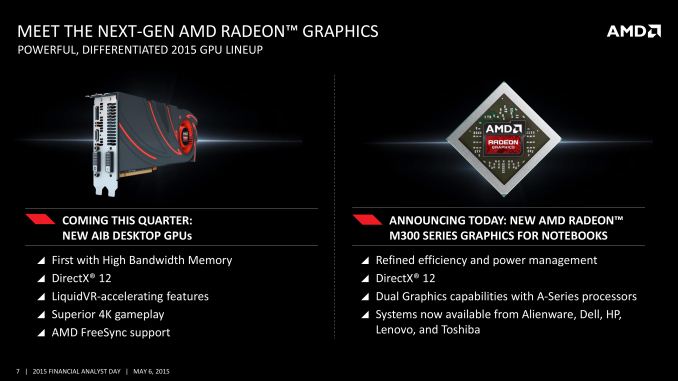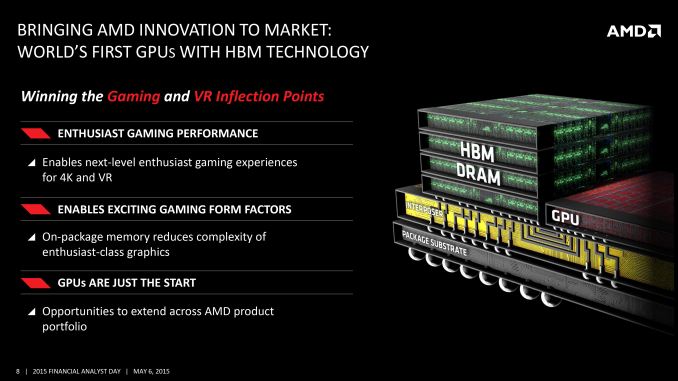AMD Dives Deep On High Bandwidth Memory - What Will HBM Bring AMD?
by Ryan Smith on May 19, 2015 8:40 AM EST
Though it didn’t garner much attention at the time, in 2011 AMD and memory manufacturer Hynix (now SK Hynix) publicly announced plans to work together on the development and deployment of a next generation memory standard: High Bandwidth Memory (HBM). Essentially pitched as the successor to GDDR, HBM would implement some very significant changes in the working of memory in order to further improve memory bandwidth and turn back the dial on memory power consumption.
AMD (and graphics predecessor ATI) for their part have in the last decade been on the cutting edge of adopting new memory technologies in the graphics space, being the first to deploy products based on the last 2 graphics DDR standards, GDDR4, and GDDR5. Consequently, AMD and Hynix’s announcement, though not a big deal at the time, was a logical extension of AMD’s past behavior in continuing to explore new memory technologies for future products. Assuming everything were to go well for the AMD and Hynix coalition – something that was likely, but not necessarily a given – in a few years the two companies would be able to bring the technology to market.

AMD Financial Analyst Day 2015
It’s now 4 years later, and successful experimentation has given way to productization. Earlier this month at AMD’s 2015 Financial Analyst day, the company announced that they would be releasing their first HBM-equipped GPU – the world’s first HBM-equipped GPU, in fact – to the retail market this quarter. Since then there have been a number of questions of just what AMD intends to do with HBM and just what it means for their products (is it as big of a deal as it seems?), and while AMD is not yet ready to reveal the details of their forthcoming HBM-equipped GPU, the company is looking to hit the ground running on HBM in order to explain what the technology is and what it can do for their products ahead of the GPU launch later that quarter.
To date there have been a number of presentations released on HBM, including by memory manufactures, the JEDEC groups responsible for shaping HBM, AMD, and even NVIDIA. So although the first HBM products have yet to hit retail shelves, the underpinnings of HBM are well understood, at least inside of engineering circles. In fact it’s the fact that HBM is really only well understood within those technical circles that’s driving AMD’s latest disclosure today. AMD sees HBM as a significant competitive advantage over the next year, and with existing HBM presentations having been geared towards engineers, academia, and investors, AMD is looking to take the next step and reach out to end-users about HBM technology.
This brings us to the topic of today’s article: AMD’s deep dive disclosure on High Bandwidth Memory. Looking to set the stage ahead of their next GPU launch, AMD is reaching out to technical and gaming press to get the word out about HBM and what it means for AMD’s products. Ideally for AMD, an early disclosure on HBM can help to drum up interest in their forthcoming GPU before it launches later this quarter, but if nothing else it can help answer some burning questions about what to expect ahead of the launch. So with that in mind, let’s dive in.
I'd also like to throw out a quick thank you to AMD Product CTO and Corporate Fellow Joe Macri, who fielded far too many questions about HBM.











163 Comments
View All Comments
testbug00 - Tuesday, May 19, 2015 - link
Nvidia didn't really have a choice, GDDR5 was *barely* ready for the 4870 iirc. Nvidia would have had to hold back finished cards for months to be able to get GDDR5 on them. Actually, they would have had to take a bet on if GDDR5 would be ready for production at that point.It isn't as simple as flipping a switch and having the GDDR5 controller work for GDDR3. It would require additional parts, leading to less dies per wafer and lower yield.
Nvidia did what was required to ensure their part would be able to get to market ASAP with enough memory bandwidth to drive it's shaders.
silverblue - Wednesday, May 20, 2015 - link
Very true.testbug00 - Tuesday, May 19, 2015 - link
Each chip if GDDR5 has a voltage, correct? So, each additional chip consumes more power?Maybe I'm missing something.
Ryan Smith - Tuesday, May 19, 2015 - link
An exceptional amount of energy is spent on the bus and host controller, which is why GDDR power consumption is such a growing issue. At any rate, yes, more chips will result in increased power, but we don't have a more accurate estimation at this time. The primary point is that the theoretical HBM configuration will draw half the power (or less) of the GDDR5 configurations.Shadowmaster625 - Tuesday, May 19, 2015 - link
Take 2048 shaders, 16GB of HBM, 4 CPU cores and a PCH, slap it onto a pcb, and ship it.silverblue - Tuesday, May 19, 2015 - link
Don't forget the SSD. ;)Ashinjuka - Tuesday, May 19, 2015 - link
Ladies and gentlemen, I give you... The MacBook Hair.Crunchy005 - Tuesday, May 19, 2015 - link
Put it all under a IHS and a giant heat sync on top with one fan.mr_tawan - Wednesday, May 20, 2015 - link
I was about to say the samething :)DanNeely - Tuesday, May 19, 2015 - link
Honestly I'm most interested in seeing what this is going to do for card sizes. As the decreased footprints for a GPU+HBM stack in AMD's planning numbers or nVidia's Pascal prototype show there's a potential for significantly smaller cards in the future.Water cooling enthusiasts look like big potential winners; a universal block would cover the ram too instead of just the GPU, and full coverage blocks could be significantly cheaper to manufacture.
I'm not so sure about the situation for air cooled cards though. Blower designs shouldn't be affected much; but no one really likes those. Open air designs look like they're more at risk though. If you shorten the card significantly you end up with only room for two fans on the heatsink instead of three; meaning you'd either have to accept reduced cooling or higher and louder fan speeds. That or have the cooler significantly overhang the PCB I suppose. Actually that has me wondering how or if being able to blow air directly through the heatsink instead of in the top and out the sides would impact cooling,